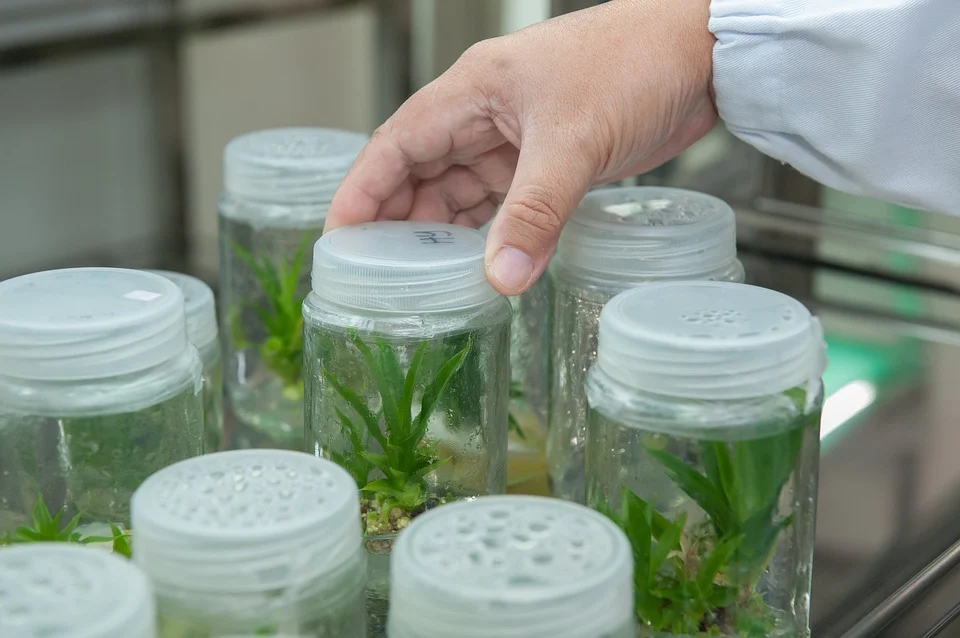
Tissue culture cups are cups that contain portions of pure plant power, minus the pests. They are created in sterile labs, and this means you start your scape with a clean slate: no algae and no snails!
The new plantlets can be grown in a short amount of time and only a small amount of initial plant tissue is required. The new plantlets and plants are more likely to be free of viruses and diseases and the process is not dependent on the seasons and can be done throughout the year.
Plants grown from tissue culture, called Invitro plants, have become more and more popular in recent years. These aquatic plants are cultivated under laboratory conditions, and they are sold directly in their culture cups in the form of small plastic containers with a lid.

With all other cultivation methods for commercially available plants, the plants are not sterile, even though the potted aquarium plants are a true classic. Most potted plants are cultivated in their emerging form in special aquatic plant nurseries, which means they are grown with their green parts above the waterline. Usually, rock wool is used as a substrate.
Potted plants that have been cultivated underwater are also available, especially for those species that would otherwise not survive above water. Submerged plants, especially stem plants, are also available in bunches, floating plants are mostly sold in portions, in a plastic cup.
The real question is, are you better off purchasing tissue culture cups or regular potted plants?

Invitro Plants
Aquatic plants from tissue culture offer several benefits. They are free from pesticides and unwanted extraneous organisms such as parasites, pathogens, snails, planarians, insect larvae, algae, and annoying “weeds” such as duckweed. The pesky removal of rock wool is omitted completely. And with one portion you get quite a large number of small individual plants.
The great advantage of in-vitro cultivation is that the plants are grown under sterile conditions. Aquarium plants in this form can therefore be sold as free from pesticides, pests, foreign plants, algae spores, and germs. However, if an in vitro pot is damaged or opened, for example by improper use, contamination by foreign organisms may occur, such as moulds, yeasts, or bacteria.

Therefore, when handling in-vitro goods, care must be taken to ensure that the cups always remain closed and intact at all times. Once opened, sterile cups should also be completely used up so that no plant remains to stay inside the open pot together with the nutrient medium for a longer period.
In-vitro aquatic plants usually stand out due to their dwarfish appearance. While leaves and stems are very small, the root system can be disproportionately large – or super tiny. The dwarfish growth is due to the nature and contents of the nutrient medium.
In addition to all-important nutrients, it also contains sugar or amino acids so that the plant can significantly reduce certain parts of its metabolism and thus also the size of its organs. The hormonal balance of the in-vitro aquarium plants, which is altered by the addition of phytohormones, also contributes to this small growth and the “strange” root growth.

Aquatic plants from in-vitro cultures can easily be prepared for aquarium use. In contrast to potted goods, there is no need to pluck the plants out of the rock wool. The most important thing is to remove the nutrient medium, which can be rinsed under slightly tempered, running water, or dissolved in a longer water bath without further action.
Depending on the type of plant, it is advisable to divide the contents of the cup into smaller individual plants or portions. This makes planting much easier and the content much more productive concerning the area planted. This is particularly important for plants that cover the ground.

Potted Plants
Potted aquarium plants are plants cultivated in their emerged form. Their roots grow in a special substrate in a plastic mesh-pot, where they are fed with a special nutrient solution in the aquatic plant nursery.
The substrate usually consists of rock wool but may be made of coconut fibre in some cases. It may contain residues of fertilisers, and possibly also algae or extraneous plants such as duckweed. Therefore, you should remove the substrate as completely as possible before you use the plants in your aquarium.

In rare cases, emerged potted plants might bring with them tiny pests that had moved in during their time in the plant nursery. These may be little slugs or insects like aphids, whiteflies, and thrips. This is usually not an issue when the plants are used in an aquarium, since those critters are land-dwellers and cannot survive underwater, moreover, they would soon be eaten by the ornamental fish in the tank.
There is usually no aquatic fauna such as aquatic snails, planarians, and other worms on emerging potted plants themselves, but the pots are usually placed in the water during cultivation and storage, so such “co-pilots” in the pots and substrate cannot be ruled out completely. This is especially the case with submerged potted plants such as Blyxa japonica or Vallisneria.

The most prominent feature of emerged potted plants is their robustness. Another important criterion is that the plants already have some height because potted plants like ferns, stem plants, and rosette plants are generally much larger in girth and size than in vitro plants.

Final Words
Are these tissue culture cups worth their price?
Not really, there is no definite promise that the plants will survive once cultivated and the process of adding them to your tank is much more tedious than that of potted plants.
So you are probably better off purchasing a potted plant and using the quarantine method to avoid any cross contamination of diseases.










